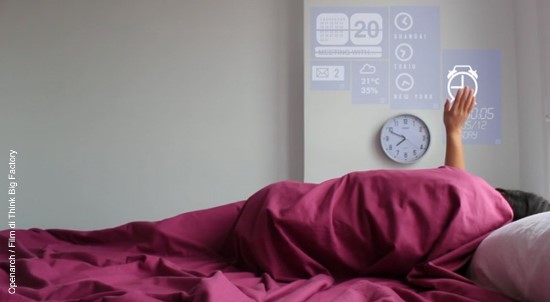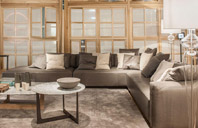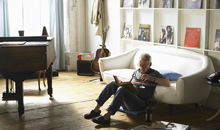LivingScapes: Contemporary styles of life and living (Part III)
Source:Salone del Mobile.Milano Trend Lab
The home is the most intimate yet also the most social place in which we live our lives. Lifestyles are in continuous evolution, and it is in the home – the theater and stage of our daily experience – that the most significant socio-economic, technological and cultural changes manifest themselves, fruit of the advanced present we live in, and of our imagined future.

Phygital House
Hyperconnected & intelligent living
The home as a new bridge between the physical and digital worlds. Domestic furnishings and objects become the interface through which these two worlds communicate, creating a seamless experiential continuum. This condition of smart connectivity makes the management of residential spaces fluid (even remotely), capable of responding in real time to the needs the inhabitants, transforming the home into a responsive, adaptive ecosystem. Furnishings are technologically ‘augmented’, acquiring genuine ‘superpowers’.
A lot has already been said about the Internet of Things, so the time has come to attempt to live the dream [of] a user-centered model, a citizen-centered model, an open-source collaborative model. (Bruce Sterling)
[…] and obviously domotic systems (remote control of temperature, water, energy use), intelligent appliances and everything required for amusement, because the home of the future will always have to be ready to entertain guests.
Shared House
Community living
It is the community-driven home that translates new possibilities of collaborative living, and ‘chosen families’ – those not bound by blood – who elect to cohabit by sharing the spaces of their domestic lives, giving rise to new formulas and typologies of living. It is the place where cohabitation is designed by people who share habits, values, inclinations and existential choices, or by humans and animals, full-fledged ‘houesemates’ with their own specific needs.
Middle-aged people are having had to find room in their homes both for their grown-up children and their elderly parents as traditional large households make a comeback. On one side, extended adolescence and high youth unemployment is leading to young people living with their parents for longer. On the other, older people are living for longer and reach a time when they can no longer look after themselves or afford the care they need to live independently. (Kevin McCullagh, Designer and Forecaster).
This propensity for cohabitation is owed to several factors: the evolution of families’ need for space and the life expectations of their members; the development of temporary work projects and nomadic habits; the necessity of saving money by sharing and reducing housing costs. Cohabitation means that the home tends to increasingly become a space of variable geometry, capable of adapting to shifting demands. It also means companionship, socialization and greater attention to food culture. The kitchen replaces the TV room as the central place of interaction among cohabiting individuals. (Stefano Boeri).
THE9LIFE is a lifestyle brand of home products & furniture for stylish people who share their homes with cats. Our homes are our refuge and our cats are our faithful companions! This is why we design beautiful environments where both humans and cats can cohabitate happily. (from the website of the Japanese design studio THE9LIFE).
Enabling House
Living in wellness
This is the home that actively contributes to the wellness of its inhabitants through furnishings that ‘take care’ of those who use them, fostering ‘healthy’ behaviors and interactions for the body and mind.
It is the home that helps those who are not able to manage on their own due to incapacitating illness or old age. Faced with ever lengthening life expectancies, it is the place where design assumes a therapeutic character, for people with reduced mobility or functionality.
I like the idea of furniture that can transform into prostheses […] Design, more than a module for furnishing our homes, must be a tool capable of providing support to our lives. (Francesca Lanzavecchia, Designer).
SuperNormal House
Basic living
This is the home that simplifies life, where practicality and functionality come first and foremost, without sacrificing esthetic considerations. It designs ordinary everyday life in a simple and intelligent way, but never trivial, using minimal objects with high functional value capable of impacting positively on the quality of domestic life, or ‘redesigned’ everyday objects that make normality special. This return to an essential way of life also embraces low-consumption and lowintensity technologies.
I don’t care if the designs become less noticeable. In fact a certain lack of noticeability has become a requirement […] Special is generally less useful than normal […] The super normal object is the result of a long tradition of evolutionary advancement in the shape of everyday things. (Jasper Morrison, Designer)
I try to make my objects speak for themselves, and I hope this is the case! If someone asks me to design a drinking glass, it wouldn’t matter to me to be able to determine the color, form, size or material, but to understand how much water it can hold. But if the glass is placed at the center of the table or at the edge, it conveys a different feeling. This is the language that I want my objects to have. They are very, very small matters, but they are important to me. (Oki Sato, founder of Nendo)
I don’t try to design the stars, but the darkness around them: that’s what makes them so beautiful. (Oki Sato)
Nomadic House
Temporary living
This is the home that responds to the desire for mobility and change.
Like a mirror of the shifting fluidity of contemporary life, furnishings become easy to move and/or disassemble to facilitate the repositioning and/or reconfiguration of the living space. Taken to its extreme, the nomadic way of life is asserting itself as a new theme in the design of ‘portable’ living solutions. They are homes in every way, with all the comforts that can be easily set up in any part of the world, be it in the city or the countryside, redefining the landscapes around them.
This trend resonates with the reality of many young urbanites, who accept transience and uncertainty as the norm. In their search for education, experience and work, they live with less in rented compact spaces. With limited incomes, they are choosing inner-city access over excess possessions and living space. These considered consumers own a small number of prized possessions – that can be packed into a few suitcases – and access non-core products services via the shared economy. (Kevin McCullagh, Designer e Forecaster).
(Source: Salone del Mobile.Milano Trend Lab)





 沪公网安备31010402003309号
沪公网安备31010402003309号



